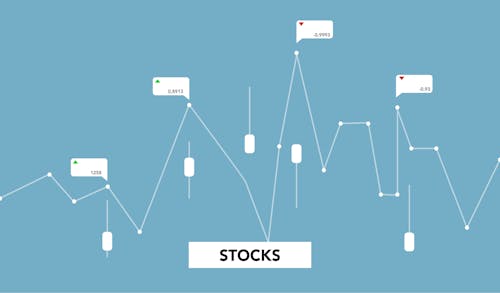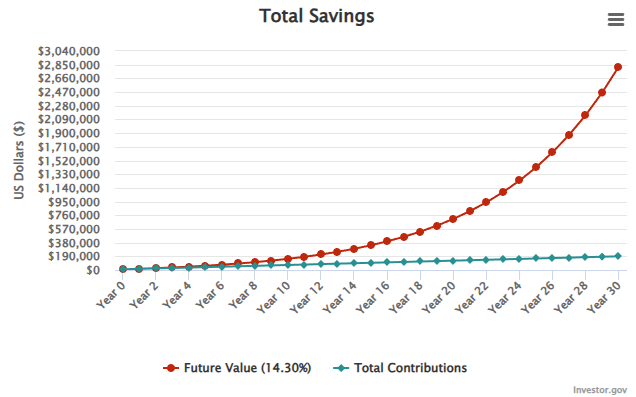Historical Average Returns For Nasdaq 100 Index

Image Source: Pexels
The Nasdaq 100 has a reputation for producing large returns over time but with significant volatility. The Nasdaq 100 is considered a benchmark for technology stocks, as it includes the largest 100 non-financial stocks on the Nasdaq Stock Exchange. These companies are mainly involved in technology-related businesses.
The Nasdaq 100 index was launched in 1985. The Invesco QQQ Trust (QQQ), which tracks the Nasdaq 100 index, was launched in 1999.
In this article, you’ll see how the Nasdaq 100 has performed over the last 1, 3, 5, 10, and 20 years.
Over the last 20 years, the Nasdaq 100 has outperformed the S&P 500 returns by a significant margin.
Average returns can be deceiving because they hide the big up and down years that make up the average. Therefore, you’ll also learn the biggest up and down years have been, in percentage terms.
Average Nasdaq 100 Returns Based on QQQ
Here are the average returns for the Nasdaq 100 index for the last 20, 10, 5, 3, and 1 years. Statistics are based on the QQQ ETF which has a 0.2% yearly expense ratio, so the actual index will be slightly higher (but you can’t invest in the index without incurring fees, so these are the returns you would have actually received).
| Years Averaged (as of Aug. 7 2023) |
Nasdaq 100 Average Return Per Year (with dividends) |
Nasdaq 100 Average Return Per Year (no dividends) |
| 20 years | 14.3% | 13.5% |
| 10 years | 18.3% | 17.3% |
| 5 years | 16.4% | 15.6% |
| 3 years | 11.7% | 11.0% |
| 1 year | 17.1% | 16.3% |
Returns have been calculated based on TradingView charts.
Everyone should passively invest some funds. Set it and forget it for 10 years or more to compound your wealth.
The Passive Stock Investing Using ETFs eBook lays out how to do it, including how to capitalize on the Nasdaq 100 returns.
Making 14.3% per year, which the Nasdaq 100 has averaged over the last 20 years, produces a $2.8 million nest egg if investing $10K and adding an additional $500 each month for 30 years. Invest $190,000 total, over 30 years, to make $2.8 million. That’s the power of compounding.
That’s passively investing, not trading, and just adding a bit more to the position each month. You can use the investment calculator on Investor.gov to test out different scenarios. Note that returns may be higher or lower in the future.

The Biggest Up and Down Years for the Nasdaq 100
Many of the biggest up and down years occurred around the “tech bubble” of 2000, as well as the financial crisis of 2008 and the recovery. All figures include dividend payments and are based on the QQQ ETF unless otherwise specified.
Biggest Nasdaq 100 Index Down Years
2008: -41.7%
2002: -37.4%
2000: -36.1%
2001: -33.3%
2022: -32.6%
Biggest Nasdaq 100 Index Up Years
Dates and returns prior to 2000 are based on the Nasdaq 100 index (and thus don’t include dividends) and not QQQ.
1999: +102%
1998: +85.3%
1991: +65%
2009: +54.7%
2003: +49.7%
2020: +48.6%
1995: +42.5%
1996: +42.5%
2013: +36.6%
Nasdaq 100 Returns by Year
The following are the Nasdaq 100 returns by year based on the QQQ ETF. Returns are calculated using the close of the prior year to the last day of the return year, including dividends.
2023: 42.74%
2022: -32.6%
2021: 27.4%
2020: 48.6%
2019: 39%
2018: -0.1%
2017: 32.7%
2016: 7.1%
2015: 9.5%
2014: 19.2%
2013: 36.6%
2012: 18.1%
2011: 3.4%
2010: 20%
2009: 54.7%
2008: -41.7%
2007: 19%
2006: 7.1%
2005: 1.6%
2004: 10.5%
2003: 49.7%
2002: -37.4%
2001: -33.3%
2000: -36.1%
Nasdaq 100 Historical Chart with Rally and Decline Percentages
The Nasdaq 100 index began in 1985. The following chart shows the journey the index has taken since, including rallies and declines of more than 25% (peak to trough) over that time.
The chart is based on monthly data points. If using a shorter time frame, such as daily, there are many more 25% drops and rallies, but this chart shows the overall moves and their ultimate percentages.
The chart is logarithmic.
(Click on image to enlarge)

Nasdaq 100 ETFs
The easiest way to invest in the Nasdaq 100 is to use an exchange-traded fund (ETF). You buy and sell it like an individual stock, and the managers of the ETF make sure the fund tracks the index by buying the same stocks that are included in the Nasdaq 100.
Invesco QQQ Trust (QQQ)– a popular choice with huge daily volume and a 0.2% expense ratio per year.
Invesco Nasdaq 100 ETF (QQQM) – created for people more interested in buy-and-hold as it has a lower expense ratio of 0.15%.
An expense ratio is the cost of managing the fund, or your cost of investing in it. So if the Nasdaq index returned 10% in a year, with a 0.2% expense ratio, your return as an investor would be 9.8%.
More By This Author:
Best Performing US ETFs Of The Last 1, 3, 5, And 10 YearsAMGN Near Buy Point With Strong Fundamentals And Rising Dividend
Steps To Becoming A Profitable Trader As Quickly And Efficiently As Possible
Disclaimer: Nothing in this article is personal investment advice, or advice to buy or sell anything. Trading is risky and can result in substantial losses, even more than deposited if using ...
more


